#March 1 (Spring) | June 1 (Summer) | September 1 (Fall) | December 1 (Winter)
Explore tagged Tumblr posts
Text
2025 Witches' Calendar
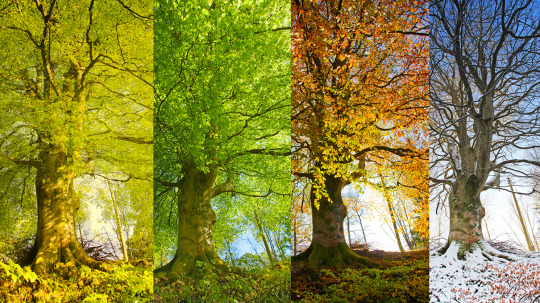
For all my witches out there, here’s a handy list of the 2025 dates for the solstices, some commonly-referenced holidays, full and new moons, and special astronomical events. I’ve listed my sources at the bottom.
Dates and times for all events are calculated for Eastern Standard Time, USA, Northern Hemisphere. Adjust for your location as needed and check the DarkSky Placefinder to see what special events will be visible in your area.
On a related note, readers are encouraged to create their own seasonal calendars, holidays, and observances based on your local biome and personal preferences. Enjoy!
Solstices, Harvests, Quarter Days, Some Common Dates
February 1-2 - Imbolc / Candlemas / High Winter
March 20 - Spring Equinox / Ostara
April 30-May 1 - Beltane / May Day / Walpurgisnacht
June 20 - Summer Solstice / Midsummer / Litha
August 1 - Lughnasadh / Lammas / Summer Harvest
September 22 - Autumn Equinox / Mabon / Fall Harvest
October 31 - Samhain / Halloween / Final Harvest
December 21 - Winter Solstice / Yule
Full Moons
January 13 - Wolf Moon ♋
February 12 - Snow Moon ♌
March 14 - Worm Moon ♍ (Lunar Eclipse)
April 12 - Pink Moon ♎
May 12 - Flower Moon ♏
June 11 - Strawberry Moon ♐
July 10 - Thunder Moon (aka Buck Moon) ♑
August 9 - Sturgeon Moon (aka Corn Moon) ♒
September 7 - Harvest Moon ♓ (Lunar Eclipse)
October 6 - Hunter's Moon (aka Blood Moon) ♈
November 5 - Frost Moon (aka Beaver Moon) ♉ (Supermoon)
December 4 - Cold Moon ♊ (Supermoon)
* The full moons in September and October are almost EXACTLY equidistant from the Autumn Equinox this year, so whether you'll have a Harvest Moon in September or October depends on where you live!
New Moons
January 29 ♒
February 27 ♓
March 29 ♈
April 27 ♉
May 26 ♊
June 25 ♋
July 24 ♌
August 23 ♍
September 21 ♍ (Seasonal black moon, second new moon in Virgo)
October 21 ♎
November 20 ♏
December 19 ♐
Special Celestial Events
March 14 - Worm Moon Total Lunar Eclipse
March 29 - Solar Eclipse
September 7 - Harvest Moon Total Lunar Eclipse
September 21 - Seasonal Black Moon / Solar Eclipse
November 5 - Frost Moon Supermoon
December 4 - Cold Moon Supermoon
(Check the DarkSky Placefinder to see what will be visible in your area!)
Mercury Retrogrades (in case you need them)
March 14 to April 6
July 17 to August 10
November 9 to November 29
Happy Witching!
SOURCES & FURTHER READING:
Bree’s Lunar Calendar Series
Bree’s Secular Celebrations Series
Moon Info - Full Moon Dates for 2025
Calendar-12 - 2025 Moon Phases
Full Moonology - 2025 Full Moon Calendar
AstroStyle - All the 2025 Full Moons
Your Zodiac Sign - Astrology Calendar 2025
Old Farmer’s Almanac - Mercury Retrograde Dates 2024-2025
Sea and Sky - Astronomy Calendar of Celestial Events 2025
DarkSky International - Dark Sky Placefinder for Stargazing
Patheos - 2025 Wheel of the Year Astrological Calendar
Image Source - How Stuff Works
=
If you’re enjoying my content, please feel free to drop a little something in the tip jar, tune in to my podcast Hex Positive, or check out my published works on Amazon or in the Willow Wings Witch Shop. 😊
2K notes
·
View notes
Text

Snowcapped mountains serve as a backdrop to verdant landscapes at Gran Paradiso National Park in Valle d'Aosta, Italy. When does each new season start? Some measure seasonal shifts by Earth’s position relative to the sun, while others use annual temperature cycles. Photograph By Stefano Unterthiner
Every Season Actually Begins Twice—Here’s Why
Seasons can be defined in two different ways: Astronomical and Meteorological. We explain what they mean, and how to tell them apart.
— By Amy McKeever | May 31, 2023
Every three months, a new season begins—twice.
Spring creeps in like a lion on March 1, and then again a few weeks later with the equinox. Likewise, some people welcome the arrival of summer on June 1, while others celebrate it a few weeks later with the solstice. So who is right about when the seasons begin and end?
It depends on why you’re asking. Seasons are defined in two ways: Astronomical seasons, which are based on Earth’s position as it rotates around the sun, and Meteorological seasons, which are based on annual temperature cycles. Both divide the year into spring, summer, fall, and winter—yet with slightly different start and end dates for each. Here’s what they mean and how to tell them apart.
What are Astronomical Seasons?
People have always looked to the skies to determine the season. Ancient Rome was the first to officially mark those seasons with the introduction of the Julian calendar. Back then, the seasons began on different days than the modern era because of discrepancies with the Gregorian calendar used primarily today. Now, the start of each astronomical season is marked by either an equinox or a solstice.
Equinoxes are when Earth’s day is split almost in half. They occur every six months in the spring and fall, when Earth’s orbit and its axial tilt combine so that the sun sits directly above the Equator. On an equinox, roughly half the planet is light while the other half is dark. As the new season progresses, the sun’s position continues to change—and, depending which hemisphere you live in, the days will get progressively lighter or darker until the arrival of the solstice.
Solstices mark the brightest and darkest days of the year. They are also driven by Earth’s tilt and mark the beginning of astronomical summer and winter. When the Northern Hemisphere is tilted toward the sun, it is brighter and feels like summer—while, at the same time, the Southern Hemisphere is tilted away from the sun, plunging it into a dark winter.
But this method of measuring the seasons presents some challenges. The solar year is approximately 365.2422 Earth days long, making it impossible for any calendar to perfectly sync with Earth’s rotation around the sun. As a result, astronomical seasons start on slightly different days and times each year—making it difficult to keep the climate statistics that are used in agriculture, commerce, and more. That’s why weather forecasters and climatologists turned to meteorological seasons instead.

What are Meteorological Seasons?
Since at least the 18th century, scientists have sought better methods of predicting growing seasons and other weather phenomena. Over time, that gave rise to the concept of meteorological seasons, which are more closely aligned with both annual temperatures and the civil calendar.
Meteorological seasons are far simpler than astronomical seasons. They divide the calendar year into four seasons that each last exactly three months and are based on the annual temperature cycle. Winter takes place during the coldest three months of the year, summer in the hottest three months, and spring and fall mark the remaining transition months.
In the Northern Hemisphere, that means the start date for each season is March 1 (spring), June 1 (summer), September 1 (fall), and December 1 (winter). In the Southern Hemisphere, the seasons are reversed; spring begins in September, summer in December, fall in March, and winter in June.
The consistency of meteorological seasons allows meteorologists to make the complex statistical calculations necessary to make predictions and compare seasons to one another. “Dealing with whole-month chunks of data rather than fractions of months was more economical and made more sense,” climatologist Derek Arndt told the Washington Post in 2014. “We organize our lives more around months than astronomical seasons, so our information follows suit.”
So when is the first day of every season? It isn’t the first of the month or the position of the sun—it’s both.
#Environment#Seasons | Astronomical and Meteorological#Gran Paradiso National Park | Valle d'Aosta | Italy 🇮🇹#Earth’s Position | Rotation | Sun | Annual Temperature Cyclees#Equinoxes#Equator#Light 💡 | Darkness#March 1 (Spring) | June 1 (Summer) | September 1 (Fall) | December 1 (Winter)
0 notes
Photo
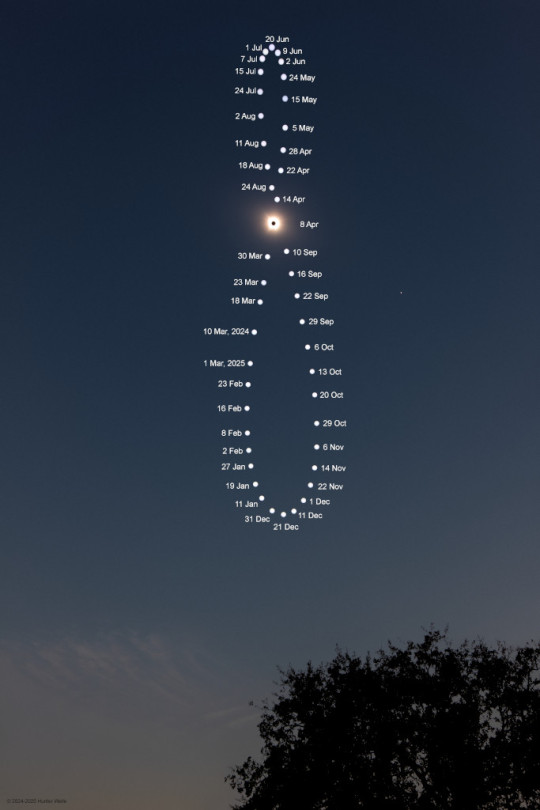
2025 March 20
The Solar Eclipse Analemma Project Image Credit & Copyright: Hunter Wells
Explanation: Recorded from 2024 March 10, to 2025 March 1, this composited series of images reveals a pattern in the seasonal drift of the Sun's daily motion through planet Earth's sky. Known to some as an analemma, the figure-eight curve was captured in exposures taken on the indicated dates only at 18:38 UTC from the exact same location south of Stephenville, Texas. The Sun's position on the 2024 solstice dates of June 20 and December 21 would be at the top and bottom of the curve and correspond to the astronomical beginning of summer and winter in the north. Points that lie along the curve half-way between the solstices would mark the equinoxes. The 2024 equinox on September 22, and in 2025 the equinox on March 20 (today) are the start of northern fall and spring. And since one of the exposures was made on 2024 April 8 from the Stephenville location at 18:38:40 UTC, this analemma project also reveals the solar corona in planet Earth's sky during a total solar eclipse.
∞ Source: apod.nasa.gov/apod/ap250320.html
153 notes
·
View notes
Photo

The Wheel of the Year is a symbol of the eight Sabbats (religious festivals) of Neo-Paganism and the Wicca movement which includes four solar festivals - Winter Solstice, Spring Equinox, Summer Solstice, Fall Equinox - and four seasonal festivals - celebrating or marking a significant seasonal change. Contrary to modern-day Wiccan claims, there is no evidence of an ancient Wheel of the Year in its present form but it is clear that the Celts of thousands of years ago celebrated the festivals the wheel highlights, even if these celebrations were known by another name now long lost. In the ancient Celtic culture, as in many of the past, time was seen as cyclical. The seasons changed, people died, but nothing was ever finally lost because everything returned again – in one way or another – in a repeating natural cycle. Although time in the modern world is usually regarded as linear, the cyclical nature of life continues to be recognized. The modern-day Wheel of the Year was first suggested by the scholar and mythologist Jacob Grimm (1785-1863) in his 1835 work, Teutonic Mythology, and fixed in its present form in the 1950s and early '60s by the Wicca movement. The wheel includes the following holy days (most dates flexible year-to-year): Samhain (31 October) Yule (20-25 December) Imbolc (1-2 February) Ostara (20-23 March) Beltane (30 April-1 May) Litha (20-22 June) Lughnasadh (1 August) Mabon (20-23 September). These eight festivals are designed to draw one's attention to what one has gained and lost in the cyclical turn of the year. As in the ancient Egyptian civilization (and others), the Celts believed that ingratitude was a 'gateway sin' which then led a person into the darkness of bitterness, pride, resentment, and self-pity. By pausing to reflect upon gratitude for what one had been given in a year, as well as what one had lost but still cherished in memory, one maintained balance.
91 notes
·
View notes
Text
I don't like how the birthdays from stardew valley are set up in the real world. Like most of December is in the fall according to the solstice but Sebastian's birthday is winter 10 and we've decided it's December 10th.
Nah, let's give all the characters accurate birthdays in accordance with the seasons.
I'll set it up 2 ways:
1. Taking the earliest dates of each solstice and equinox that defines the seasons and dividing that by 28 (number of days in a stardew valley season) then multiplied that number by the NPC's bday (I'll explain the math later)
2. Taking the average amount of days in-between each IRL season and dividing that by 28
Earliest dates are as follows:
Spring March 19
Summer June 20
Autumn September 21
Winter December 20
The length of each season in this method is
91 days for spring
93 days for summer
90 days for fall
90 days for winter
The average days in between is 91.5 days.
Dividing by 28 we get
3.25 Spring
3.32142857 Summer
3.2142857 Autumn / Winter
3.267857142857143 Average
These numbers are the difference between our real world dates and stardew valley dates
Our season are about 90 days long, their's are 28 days so
1 day for stardew players is about 3 days for us.
Now that we have these numbers let's find out how each day correlates to each villager.
It will be in order of earliest birthday to latest and will follow this format
NPC-Season-ingame Bday-Bday(method 1)-Bday(method 2)
Kent- Spring 4- Apr 1
Lewis- Spring 7- Apr 10
Vincent- Spring 10- Apr 20
Haley- Spring 14- May 3
Pam- Spring 18- May 16
Shane- Spring 20- May 23
Pierre- Spring 26- Jun 11
Emily- Spring 27- Jun 14- Jun 15
Jas- Summer 4- Jul 3
Gus- Summer 8- Jul 16
Maru- Summer 10- Jul 23- Jul 22
Alex- Summer 13- Aug 2- Aug 1
Sam- Summer 17- Aug 15- Aug 14
Demetrius- Summer 19- Aug 22- Aug 21
Dwarf- Summer 22- Sep 1-Aug 30
Willy- Summer 24- Sep 7- Sep 6
Leo- Summer 26- Sep 14- Sep 12
Penny- Autumn 2- Sep 27
Elliott- Autumn 5- Oct 7
Jodi- Autumn 11- Oct 26
Abigail- Autumn 13- Nov 1- Nov 2
Sandy- Autumn 15- Nov 8- Nov 9
Marnie- Autumn 18- Nov 17- Nov 18
Robin- Autumn 21- Nov 27- Nov 28
George- Autumn 24- Dec 7- Dec 8
Krobus- Winter 1- Dec 23
Linus- Winter 3- Dec 29
Caroline- Winter 7- Jan 11
Sebastian- Winter 10- Jan 21
Harvey- Winter 14- Feb 2- Feb 3
Wizard- Winter 17- Feb 12- Feb 13
Evelyn- Winter 20- Feb 22- Feb 23
Leah- Winter 23- Mar 3- Mar 5
Clint- Winter 26- Mar 13- Mar 14
If there is only one date on the NPC that means both dates are the same
I'd like to thank @cloverbug83 for helping with the math.
TL:DR The dates in stardew valley are incorrect and I updated them according to IRL seasons.
#sebastian stardew#stardew valley#stardew shane#sdv#sdv alex#sdv abigail#sdv harvey#sdv headcanons#sdv haley#sdv wizard#sdv kent#sdv leah#sdv lewis#sdv vincent#sdv pam#sdv pierre#sdv emily#sdv jas#sdv gus#sdv maru#sdv sam#sdv demetrius#sdv dwarf#sdv willy#sdv leo#sdv penny#sdv elliott#sdv jodi#sdv sandy#sdv marnie
427 notes
·
View notes
Text
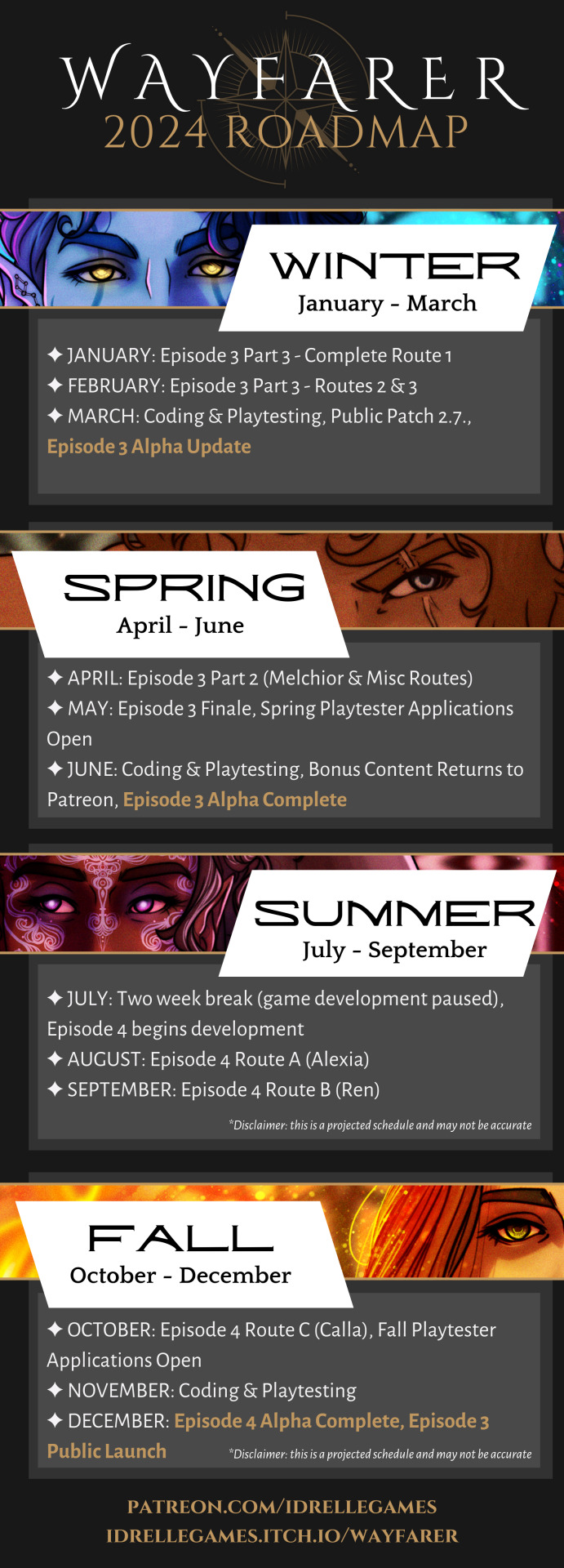
Wayfarer 2024 Roadmap
It’s the start of a new year and I’m excited to announce my plans for Wayfarer’s development.
The primary focus for 2024 is finishing Episode 3 and starting Episode 4. My goal has always been to get the alpha build to the point where it is one episode ahead of the public build, and forcing my way through this period has been very difficult. Episode 3 has turned into a more challenging endeavour than I anticipated due to its sheer size and complexity. I did not intend to take over a year to finish it, but if I’ve learned anything from the creative process it’s that it is unpredictable and things never go according to plan.
The 2024 roadmap is for an idealized scenario. I am hoping I have given myself enough wiggle room should things go off-course. With that in mind, the plan for the last 6 months of the years is an estimate and will likely change. Regardless, the goal remains the same: finish Episode 3, finish Episode 4, and release Episode 3 publicly.
Winter • January to March
This quarter will be focused on finishing the next stages of Episode 3. Episode 3 is divided into 4 parts:
Part 1: the beginning of the episode, following the routes that occur if the player ends Episode 2 with Aeran or Veyer. This part is finished and was added to the alpha build in May 2023. It includes over 300,000 words of playable content.
Part 2: the beginning of the episode, following the routes that occur if the player ends Episode 2 with Melchior, alone, or drunk. This part was skipped over and will be returned to at a later date.
Part 3: the middle of the episode, split into three different routes that eventually bottleneck at a specific point. This part is currently in-progress, with Route 1 nearing completion.
Part 4: the episode finale
January and February will be devoted to writing Episode 3 Part 3, which includes finishing Route 1 and completing Routes 2 and 3. In March, I will code that material and playtest it. Once it has been thoroughly playtested, it will be added to the alpha build (playable on my Patreon).
March will also see an update to the public build. Patch 2.7. will not add any new content, but it will patch reported bugs in Episodes 1 and 2 and update some quality of life issues.
Spring • April to June
This quarter will be focused on writing Episode 3 Part 2, the Episode 3 finale, and coding and playtesting all of the remaining material. Should all go according to plan, the Episode 3 alpha will be finished at the end of June. All routes will be playable for members of my Patreon.
The next round of playtester applications will open in May. Playtesters are volunteers who play the alpha build in search of bugs, continuity errors, and typos. They get first access to new content, and updates and patches before anyone else does. Because Wayfarer’s gameplay includes hundreds of choices and many, many variations that build on each other, playing multiple times and checking different options is essential for testing to ensure each area of the game functions as intended.
In June bonus content (short stories, writing tutorials, worldbuilding and lore posts, etc) will return to my Patreon. It is currently on a break, but the backlog of extras and specials are available to members of the Apprentice tier.
Summer • July to September
If the Episode 3 alpha is finished on time, this quarter will start the development of Episode 4. Episode 4 is divided into three separate routes that have no-crossover and each feature a main companion. Alexia’s (Route A) will be worked on in August and Ren’s (Route B) will be worked on in September.
This is an estimated timeline and is subject to change.
Fall • October to December
The last quarter will see the end of Episode 4’s development. This includes Calla’s route (Route C) and additional coding and playtesting. A second round of playtester applications will open in October. If all goes well, December will see the release of the Episode 4 alpha on Patreon and Episode 3 will launch on the public build.
This is an estimated timeline and is subject to change.
228 notes
·
View notes
Text
Shoujosei (Shoujo and Josei) Anime to look forward to in 2024
With the return of Kimi no Todoke after 12 years, I welcome all to the Shoujo renaissance! Let’s roll on the hype train! (MyAnimeList links are in titles)
Winter Anime Season (January - March)
Momochi-san Chi no Ayakashi Ouji Airs January 6th
Loop 7-kaime no Akuyaku Reijou wa, Moto Tekikoku de Jiyuu Kimama na Hanayome Seikatsu wo Mankitsu suru Airs January 7th

Isekai de Mofumofu Nadenade suru Tame ni Ganbattemasu Airs January 1st
Kyuujitsu no Warumono-san Airs January 8th

Yubisaki to Renren Airs January 6th
Watashi no Shiawase na Kekkon: Watashi no Shiawase na Katachi Airs March 15th

Gekai Elise Airs January 10th
Akuyaku Reijou Level 99: Watashi wa Ura-Boss desu ga Maou dewa Arimasen Airs January 9th

30-sai made Doutei da to Mahou Tsukai ni Nareru Rashii Airs January 11th
Given movie 2:Hiiragi Mix Airs January 27th


Murai no Koi Airs February 4th

Wonderful Precure Airs February 4th
Ensemble Stars!! Tsuioku Selection Checkmate Airs March 10th

Spring Anime Season (April - June)
Hananoi-kun to Koi no Yamai Airs April 4th
Vampire Dormitory Airs April 7th

Touken Ranbu Kyoden Moyuru Honnouji Airs April 2nd
Rabbits Kingdom the Movie Airs June 14th

Tonari no Youkai-san Airs April 7th
Himitsu no AiPri Airs April 7th


Tadaima, Okaeri Airs April 9th

Summer Anime Season (July-September)
Senpai wa Otokonoko Airs July 5th
Madougushi Dahlia wa Utsumukanai: Kyou kara Jiyuu na Shokunin Life Airs July 6th

Tasogare Out Focus Airs July 7th
SutoPuri Movie: Hajimari no Monogatari Airs July 19th
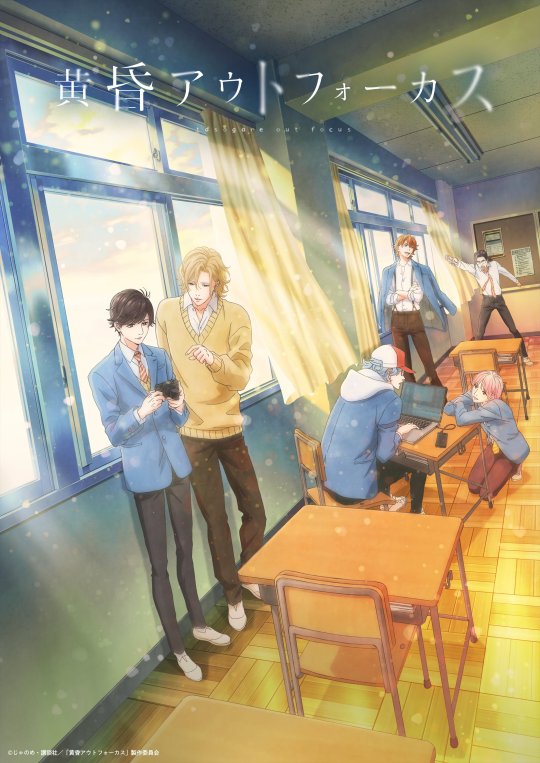

Kimi ni Todoke 3rd Season Airs August 1st
Yeosin Gangnim Airs August 7th

King of Prism: Dramatic Prism 1 Airs August 16th
Given movie 3: Umi e Airs September 20th


Fall Anime Season (October - December)
Hoshifuru Oukoku no Nina Airs in October
Rekishi ni Nokoru Akujo ni Naru zo: Akuyaku Reijou ni Naru hodo Ouji no Dekiai wa Kasoku suru you desu! Airs in October

Natsume Yuujinchou Shichi Airs in October
Goukon ni Ittara Onna ga Inakatta Hanashi Airs in October

Acro Trip Airs in October
Haigakura Airs in October

Yarinaoshi Reijou wa Ryuutei Heika wo Kouryakuchuu Airs in October
Taishou Itsuwari Bridal: Migawari Hanayome to Gunpuku no Mouai Airs October 7th


Tono to Ino Airs October 10th
Hyakushou Kizoku 2nd Season Airs October 4th


30-sai made Doutei da to Mahou Tsukai ni Nareru Rashii Movie Airs December 13th

#anime#anime 2024#shojo anime#josei anime#shoujo anime#Shoujosei#shojosei anime#anime adaptation#Momochi-san Chi no Ayakashi Ouji#loop 7 kaime no akuyaku reijou wa#yubisaki to renren#isekai de mofumofu nadenade suru tame ni ganbattemasu.#mr villain's day off#Doctor Elise: The Royal Lady with the Lamp#my happy marriage#watashi no shiawase na kekkon#Hananoi-kun to Koi no Yamai#vampire dormitory#wonderful precure#mahoutsukai precure#Acro Trip#Nina of the Starry Kingdom#kimi ni todoke#Natsume Yuujinchou#akuyaku reijou level 99: watashi wa ura boss desu ga maou de wa arimasen#Yarinaoshi Reijou wa Ryuutei Heika wo Kouryakuchuu#puella magi madoka magica
80 notes
·
View notes
Text
Sparks Album Seasons (Part 1)
Because I’m an absolutely normal album enjoyer, I find that I associate certain albums with certain seasons and I’ve decided to sort all of the Sparks albums into what season I think they belong to! I’m curious if anyone else has completely different takes (or if anyone actually does this too haha)
Halfnelson/Sparks
Fall. Kind of split on this one, sometimes feels like a summer album but then I have the stupid association of Biology 2 with starting a new semester at school since it was a funny ritual to play it before my midterms. But then Fletcher Honorama reminds me of a lazy summer afternoon.
A Woofer In Tweeter’s Clothing
Fall. Without a doubt, pure September/October territory. Everything screams windy fall evening and shorter days!
Kimono My House
Spring, but very early. Just a hint of warmer days. Maybe even end of winter. An album you put on when you kimono your house at the end of a still chilly day.
Propaganda
Winter. I don’t make the rules, this is a purely January album. Definitely not because I first heard it then and have memories about listening to only this one January.
Indiscreet
Spring/Summer. May/June energy, not the heat of summer but something to throw on when you wish it was.
Big Beat
Winter. But I don’t listen to this one too often… It screams bitter, harsh cold of winter because it’s Sparks screaming on instruments
Introducing Sparks
Summer. All those people asking ‘did I just write the album of the summer 🔥🔥🥵🤔🤔🤨😎’, no. You did not. Sparks did in 1977 and it is this one. Pure July, walking along the beach blaring this on a boombox album.
No. 1 In Heaven
Winter. Also a blustery winter album for me. I can’t explain it.
Terminal Jive
Summer. This one is like an August album. One to put on when you’re cruisin’ down the highway like the noisy boy you are.
Whomp That Sucker
Winter. This one, out of all of them is the December album for me, I have no idea… someone whomp some sense into me, because it is not a December themed album by any means, but it is to me.
Angst In My Pants
Summer. Pure June/July album to dance around to, 4th of July energy.
In Outer Space
Spring. Definitely March, it hits hard when the days are getting warmer with the sun, but there’s still this chilly wind. If you squint hard enough, it also looks like Ron got hit in the face with a snowball so that’s my justification.
Pulling Rabbits Out of a Hat
Summer. August, almost early September but not fall. Blaring this on the patio as the nights get a bit cooler. Everbody Move [sic]!
#part 2 to come#I’m genuinely curious if anyone else has opinions on this#sparks#ron mael#russell mael
23 notes
·
View notes
Text
the academy | schedule
------------------------------------------------------------------------------
date: march 27/28, 2025. started: 11:20. ended: 12:52
------------------------------------------------------------------------------





✧˖*°࿐Key Points of the Veltrius Lumos Academy Schedule
𓂃༊ monday-thursday: full academic days with breaks and extracurricular activities in the afternoon.
𓂃༊ friday: a slightly shorter academic day, allowing time for students to prepare for weekend activities or rest.
𓂃༊ saturday: mainly reserved for sports & club activities, though some competitions, rehearsals, or study groups may take place.
𓂃༊ sunday: a flexible day for personal study, socialization, and club-organized events in the evening.
𓂃༊ year 2 & 3 free periods: upper-year students get early dismissal privileges if they are not involved in extracurriculars.


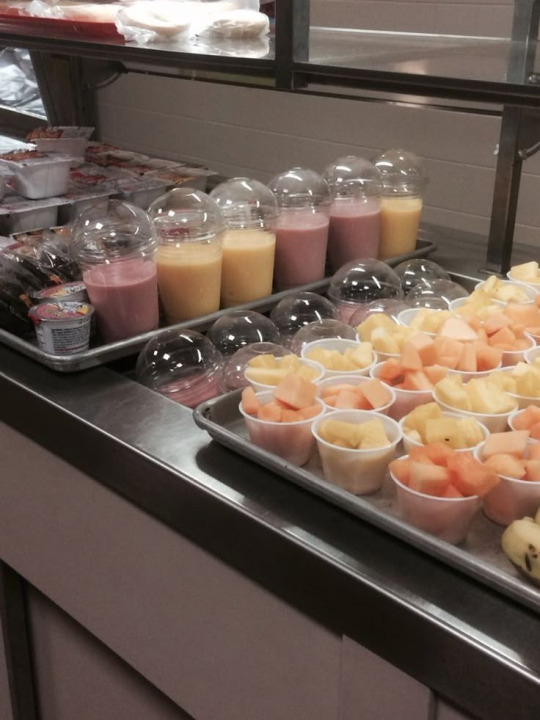


✧˖*°࿐Weekly and Daily Enhancements
*ೃ༄Morning Routine & Academic Time
𓂃༊ library opens at 5:45 AM for early studying.
𓂃༊ dormitory wake-up call is 6:00 AM, though students are expected to wake up on their own.
𓂃༊ breakfast is buffet-style, with a mix of international cuisine, healthy options, and student favorites.
𓂃༊ morning meditation & yoga (optional) is held 6:15 - 7:00 AM in the gardens for relaxation before classes.
𓂃༊ 8:20 AM: students must be in their first-period classrooms. anyone late after 8:30 AM requires a late pass.
*ೃ༄Class & Break Times
𓂃༊ morning break (10:10 - 10:20 AM): students can grab snacks, socialize, or study.
𓂃༊ afternoon break (1:40 - 1:50 PM): a short reset before the final academic period.
𓂃༊ study Hall (optional): 8th-period study hall for students who are behind or need additional tutoring.





✧˖*°࿐Saturday & Sunday Schedule
𓂃༊ since saturday & sunday are more relaxed, students have the freedom to choose their schedules, with set times for activities.
*ೃ༄Saturdays
𓂃༊ 10:00 AM - 12:00 PM: clubs & workshops (art, debate, music, science, etc.)
𓂃༊ 12:00 PM - 1:30 PM: lunch & social time
𓂃༊ 2:00 - 4:30 PM: sports games & competitions (certain teams have scheduled matches).
𓂃༊ 5:30 - 8:00 PM: dinners, outings, & dorm bonding activities.
𓂃༊ 9:00 - 11:00 PM: house socials, free rime, or special school events (theater performances, talent shows, stargazing events).
*ೃ༄Sundays
𓂃༊ open Day for rest, homework, or independent study.
𓂃༊ optional Field Trips or city visits for students who sign up.
𓂃༊ 7:30 PM - 9:00 PM: study Hall opens for students who need structured time to complete work.





✧˖*°࿐Academic Calendar & Holidays
𓂃༊ Veltrius Lumos Academy follows a semester-based academic calendar, with seasonal breaks, school-wide events, and cultural holidays integrated into the schedule.
*ೃ༄Key Academic Terms & Breaks
𓂃༊ two-semester system
✧ 𓂃 › fall semester → early september - mid december
✧ 𓂃 › spring semester → early january - may
✧ 𓂃 › summer term (optional) → late may - july (specialized courses, internships, travel programs)
✧ 𓂃 › graduation: late may
𓂃༊ seasonal breaks & holidays
✧ 𓂃 › autumn break: early october (1 week)
✧ 𓂃 › winter break → mid december - early january (4 weeks off)
✧ 𓂃 › spring break → mid-march (2 weeks off)
✧ 𓂃 › summer break: late-may – early september (15 weeks)
𓂃༊ other events
✧ 𓂃 › festival of life weekend (april 3-4)
✧ 𓂃 › summer solstice celebrations (june 20-21)
✧ 𓂃 › winter solstice celebrations (december 21)
𓂃༊ exam periods
✧ 𓂃 › midterms: late october & late march
✧ 𓂃 › final exams: early december & late may
𓂃༊ national & religious holidays → the school respects cultural and regional observances, allowing students time off for major celebrations.





✧˖*°࿐Notable School Events and Traditions
𓂃༊ opening ceremony (late friday of august) ✧ 𓂃 › the first official event of the academic year, where new students are welcomed, faculty introduces upcoming programs, and student leaders give speeches. the ceremony takes place in the grand auditorium, accompanied by an orchestral performance and an art showcase.
𓂃༊ house sorting & initiation (first week of school) ✧ 𓂃 › after arriving at Veltrius, students undergo the House Sorting Process, followed by a House Initiation Night, where new students participate in team-building activities, house feasts, and mentorship pairings with older students.
𓂃༊ autumn festival (september 22, autumn equinox) ✦ ˚ — a celebration of seasonal change and artistic expression
✧ 𓂃 › outdoor concerts, art exhibitions, and poetry readings
✧ 𓂃 › seasonal feasts with locally sourced ingredients
✧ 𓂃 › candle-lit reflection gatherings
𓂃༊ winter solstice festival (december 21) ✦ ˚ — students gather in the central courtyard, surrounded by lanterns and firepits
✧ 𓂃 › live storytelling and theatrical performances
✧ 𓂃 › hot chocolate and seasonal pastries
✧ 𓂃 › lantern-lighting rituals for renewal and good fortune
𓂃༊ spring equinox (march 19) ✧ 𓂃 › celebrated with garden planting, sustainability projects, and outdoor activities, this event encourages student-led eco-initiatives and hands-on learning.
𓂃༊ festival of arts & innovation (april 20) ✦ ˚ — a school-wide showcase of student work, including:
✧ 𓂃 › music recitals and dance performances
✧ 𓂃 › fashion and photography exhibitions
✧ 𓂃 › STEM and business innovation pitches
𓂃༊ final year gala (may 20) ✦ ˚ — an exclusive event for third-year students, marking their final days at Veltrius. It features:
✧ 𓂃 › an elegant dinner in the main hall
✧ 𓂃 › reflections from faculty and students
✧ 𓂃 › a farewell toast under the stars
𓂃༊ graduation ceremony (late may) ✦ ˚ — held in the Grand Courtyard
✧ 𓂃 › traditional academic dress and honors
✧ 𓂃 › a final artistic performance from the graduating class
✧ 𓂃 › the symbolic “Passing of the Flame” tradition where third-years light candles for the new students continuing their legacy.



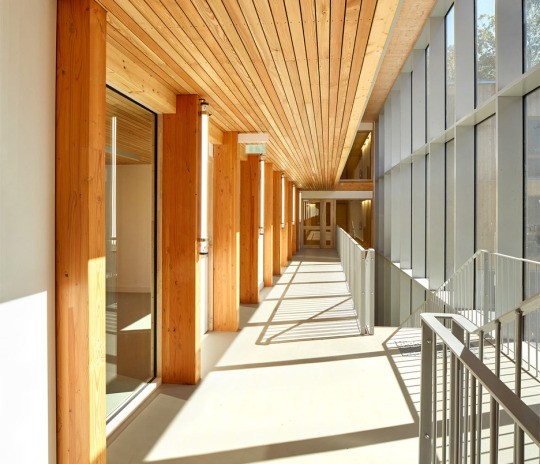

*ೃ༄ My Schedule: Year 2 (when I'm shifting)
*ೃ༄Monday - Thursday
𓂃༊ 6:20 —7:50AM: breakfast
𓂃༊ 8:30 —9:00AM: 1st period - english II (critical thinking and analytical writing)
𓂃༊ 9:05 —9:35AM: 2nd period - AP myths and legends
𓂃༊ 9:40 —10:10AM: 3rd period - algebra II w/statistics AP + precal
𓂃༊ 10:10 —10:20AM: morning break
𓂃༊ 10:25 —10:55AM: 4th period - AP world history
𓂃༊ 11:00 —11:30AM: 5th period - AP marine bio
𓂃༊ 11:30AM — 12:30PM: lunch
𓂃༊ 12:35 —1:05PM: 6th period - greek II (intermediate grammar, translation, and history)
𓂃༊ 1:10 —1:40PM: 7th period - haiqinian lang and comp AP
𓂃༊ 1:40 —1:50PM: afternoon break
𓂃༊ 1:55 —2:25PM: 8th period - fashion design
𓂃༊ 3:30 —5:30OM: sports practice (tuesday and thursday)
𓂃༊ 6:00 —7:50PM: dinner
𓂃༊ 10:30PM: curfew
*ೃ༄Friday
𓂃༊ 6:20 —7:50AM: breakfast
𓂃༊ 8:30 — 8:55AM: 1st period - english II (critical thinking and analytical writing)
𓂃༊ 9:00 —9:25AM: 2nd period - AP myths and legends
𓂃༊ 9:30 —9:55AM: 3rd period - algebra II w/statistics AP + precal
𓂃༊ 9:55 —10:05AM: morning break
𓂃༊ 10:10 — 10:35AM: 4th period - AP world history
𓂃༊ 10:40 — 11:05AM: 5th period - AP marine bio
𓂃༊ 11: 10 — 11:35AM: 6th period - greek II (intermediate grammar, translation, and history)
𓂃༊ 11:35AM — 12:35PM lunch
𓂃༊ 12:40 — 1:05PM: 7th period - haiqinian lang and comp AP
𓂃༊ 1:10 — 1:35PM: 8th period - fashion design
𓂃༊ 3:30 —5:30OM: sports practice (tuesday and thursday)
𓂃༊ 6:00 —7:50PM: dinner
𓂃༊ 10:30PM: curfew
*ೃ༄Extras
𓂃༊ saturday is reserved for extracurricular activities (sports). everyone generally have Saturday free, making it a popular time for clubs to schedule events.
𓂃༊ the same is true of sundays: clubs held some activities (usually in the evening) and people generally do homework or socialized.
𓂃༊ year 2 can get 8th period off after doing their main classes if they don’t have any extracurriculars.
𓂃༊ volleyball is primarily a fall sport (august-november), with practices also two days a week (3:00 — 5:00)
𓂃༊ figure skating would run during the winter season (november-march), with practices two days a week. (3:00 — 5:00)
#reyaint#reality shifting#shiftblr#reality shifter#shifting#shifting community#shifting motivation#anti shifters dni#dr scrapbook#dr world#boarding school dr
7 notes
·
View notes
Text
Wheel of The Year

Sabbats
Most witches celebrate eight major holy days, or sabbats, through the year, spaced roughly six and a half weeks apart. Four are called the lesser sabbats, one every three months at the solstices and equinoxes. The other four are the greater sabbats, and they are in between the lesser sabbats. Each sabbat represents a turning point in nature, reflecting the life cycle of the Earth, the God and Goddess, and often human life or the spiritual journey.
The dates of the greater sabbats (Beltane, Lughnassad, Samhain, and Imbolc) are approximate; they vary a little in different traditions. The lesser sabbats are determined by the astronomical calculations of the solstices and equinoxes, and these vary from year to year. Here’s the list, with approximate dates:
Four Solar Festivals (Quarter Days): Solstices and Equinoxes
Four Fire Festivals (Cross-Quarter Days): Midpoints between them.




🌑 Yule December 20–23
Yule marks the longest night and the rebirth of the Sun, a turning point in the wheel where darkness gives way to returning light. Rooted in Norse and Germanic traditions, it’s a time when the veil between worlds is thin, allowing for deep ancestral and spiritual communion. Yule invites us to retreat inward, honoring the cycles of death and rebirth both in nature and within ourselves.

🕯️ Imbolc February 2
Imbolc is the quickening — the subtle stirring beneath the frozen earth that signals life is returning. It is a sacred time of initiation and sacred fire, often celebrated with Brigid, who embodies inspiration, poetry, and healing. Spiritually, it calls us to clear away the old and begin envisioning the new, not in loud action, but in the quiet inner flame of intent.

🌸 Ostara March 20–23
Ostara represents the moment when light and dark are in perfect balance, before light tips forward into dominance. This sabbat echoes fertility myths across cultures and celebrates the resurrection of life after winter’s stillness. It’s a potent time for planting literal and metaphorical seeds, aligning our actions with the cycles of growth and harmony.

🔥 Beltane April 30
Beltane is a festival of sacred sensuality, where fire symbolizes not destruction, but the creative force of life. It is a celebration of polarity masculine and feminine, earth and sky, coming together in ecstatic union. Ancient rites honored fertility not only of land and livestock, but of dreams, desires, and passions ready to manifest.

☀️ Litha June 20–23
Litha is the height of the Sun’s power, when solar energy peaks before it begins its slow descent. The veil between worlds is thin in brightness as it is in shadow, and many traditions used this time to invoke protection, abundance, and healing. It's a moment to celebrate the fullness of life, while also preparing for the return of darkness.

🌾 Lughnasadh August 1
Lughnasadh, named for the Celtic god Lugh, commemorates both the first harvest and the sacrifices required for sustenance and continuation. It's a festival of gratitude and humility of recognizing the labor behind abundance. Spiritually, it teaches us to honor what we’ve created and ask what we’re willing to let go of to feed the future.

🍂 Mabon September 20–23
At Mabon, day and night are equal once again, and we are asked to reflect on the fruits of our labor. While nature prepares for descent, this moment invites a pause, a chance to express gratitude, reconcile our inner harvest, and let go of what no longer serves. Mabon is the witch’s Thanksgiving, rich with wisdom, balance, and sacred closure.

🖤 Samhain October 31
Samhain is the witch’s new year, the final spoke in the wheel where the boundary between worlds dissolves and the dead walk among the living. It is a sacred threshold between endings and beginnings, where the soul is invited to grieve, honor, and commune. It’s not just about death, but the profound transformation that death makes possible.
#wheel of the year#pagan#paganism#wicca#wiccan#witchcore#witchcraft#witchy vibes#witches#witches of tumblr#happy sabbath#witches sabbath#magick#occult#festival#celebration#holidays#yule#imbolc#ostara#beltane#litha#lammas#mabon#samhain
5 notes
·
View notes
Text
2024 Witches' Calendar
For all my witches out there, here's a handy list of the 2024 dates for the solstices, quarter days, full and new moons, and special events. I've listed my sources at the bottom.
Dates and times for all events are calculated for Eastern Standard Time, USA, Northern Hemisphere. Adjust for your location as needed and check the DarkSky Placefinder to see what special events will be visible in your area. Enjoy!
Solstices, Harvests, and Quarter Days
February 1-2 - Imbolc / Candlemas
March 19 - Spring Equinox / Ostara
April 30-May 1 - Beltane / May Day
June 20 - Summer Solstice / Midsummer / Litha
August 1 - Lughnasadh / Lammas / Summer Harvest
September 22 - Autumn Equinox / Mabon / Fall Harvest
October 31 - Samhain / Halloween / Final Harvest
December 21 - Winter Solstice / Yule
Full Moons
January 25 - Wolf Moon ♌
February 24 - Snow Moon ♍
March 25 - Worm Moon ♎
April 23 - Pink Moon ♏
May 23 - Flower Moon ♐
June 21 - Strawberry Moon ♑
July 21 - Thunder Moon (aka Buck Moon) ♑
August 19 - Sturgeon Moon* ♒
September 17 - Harvest Moon* ♓
October 17 - Hunter's Moon (aka Blood Moon)* ♈
November 15 - Frost Moon (or Beaver Moon)* ♉
December 15 - Cold Moon ♊
*- Supermoon
Fun Fact: The title of Harvest Moon is given to either the September or October full moon, whichever falls closest to the autumn equinox. Once again this year, that month will be September.
New Moons
January 11 ♑
February 9 ♒
March 10 ♓
April 8 ♈
May 7 ♉
June 6 ♊
July 5 ♋
August 4 ♌
September 2 ♍
October 2 ♎
November 1 ♏
December 1 ♐
December 30 (black moon) ♑
Special Celestial Events
January 3-4 - Quadrantids meteor shower peak
March 25 - Penumbral Lunar Eclipse
April 8 - Total solar eclipse
April 22-23 - Lyrids meteor shower peak
May 6-7 - Eta Aquarids meteor shower peak
August 11-13 - Perseids meteor shower peak
August 19 - Sturgeon Supermoon / Seasonal Blue Moon
September 17 - Harvest Supermoon / Penumbral Lunar Eclipse
October 2 - "Ring of Fire" solar eclipse
October 17 - Hunter's Supermoon
October 21-22 - Orionids meteor shower peak
November 15 - Frost Supermoon
November 16-17 - Leonids meteor shower peak
December 13-14 - Geminids meteor shower peak
December 30 - Black Moon
(Check the DarkSky Placefinder to see what will be visible in your area!)
Mercury Retrogrades (in case you need them)
April 1 - April 24
August 4 - August 27
November 25 - December 15
Happy Witching!
SOURCES & FURTHER READING:
Bree's Lunar Calendar Series
Bree's Secular Celebrations Series
Moon Info - Full Moon Dates for 2024
Calendar-12 - 2024 Moon Phases
Full Moonology - 2024 Full Moon Calendar
AstroStyle - All the 2024 Full Moons
Your Zodiac Sign - Astrology Calendar 2024
Old Farmer's Almanac - Mercury Retrograde Dates 2023-2024
Lonely Planet - Best Star-gazing Events of 2024
Sea and Sky - Astronomy Calendar of Celestial Events 2024
DarkSky International - Dark Sky Placefinder for Stargazing
Pagan Grimoire - Wheel of the Year: The 8 Festivals in the Wiccan Calendar (2024 Edition)
=
If you're enjoying my content, please feel free to drop a little something in the tip jar or check out my published works on Amazon or in the Willow Wings Witch Shop. 😊
EDIT: Mercury is stationed direct on Jan 1st, 2024. The source I used which stated it was in retrograde until the 18th had a typo.
EDIT: Fixed the zodiac signs for the full moons using a new source.
#witchcraft#witchblr#pagan#calendar#2024#full moon#new moon#lunar magic#astrology#mercury retrograde#WOTY#holidays
5K notes
·
View notes
Note
hi 👋 LPS staff I I have a three questions .
1- what are favourite food?
2-what is your birthday ?
3-what do you favourite season? (Summer ☀️. Fall🍂 . Winter. ❄️ .spring 💐)
Hello to you, too! I asked around the store and here’s what I got :)
Russell- I can’t really say if I have a favorite, but I have been in the mood for falafel recently.
Pepper- PEPPERoni pizza (hehe get it… cuz my name’s Pepper… make sure you capitalize the pepper part no no don’t write all this down Penny).
Zoe- Low-fat foie gras.
Sunil- I love mangos. They are hardly ever in season around here, though.
Vinnie- My dad’s meatballs are the best. Man, no one can make it the way my dad does. They’re really salty and meaty and… ball-y.
Minka- Bananas! Is that obvious? I don’t care!
Picking a favorite food is too hard! Hm. If I had to choose what I want right now… a big burger! Ooh! And french fries and a milkshake! How long until my lunch break again?
Birthdays
Russell- February 2, 1999 (25)
Penny- March 16, 2002 (22)
Pepper- June 14, 2000 (24)
Zoe- August 26, 2000 (24)
Sunil- September 21, 1997 (27)
Vinnie- October 21, 1998 (26)
Minka- December 14, 2001 (22)
Seasons
Russell- I enjoy the quiet of morning in the winter.
Pepper- Winter = christmas = getting stuff = THE BEST!!
Zoe- Summer lets me show off all my favorite pieces from my wardrobe, not that a silly thing like temperature could prevent me from looking fabulous, of course.
Sunil- Fall is the one time of year where I don’t catch a cold or my allergies don’t act up.
Vinnie- I say weather isn’t good until it’s over 80 degrees, so summer is the only choice for me.
Minka- SPRING!! I love all the pretty colors and the mud and the rain and the smell of flowers and…
My favorite is fall. I guess I just like the coziness of the season.
Have a nice day,
Penny Ling
#ask blog#ask the characters#asks open#human au#littlest pet shop#littlest pet shop 2012#lps 2012#vinnie terrio#russell ferguson#minka mark#zoe trent#penny ling#sunil nevla#pepper clark
16 notes
·
View notes
Note
Hey was reading thru your shutterbug and seaglass series which I wanna say is so dang cute! But I noticed in your notes you kept having issues with whatever we consider school over here in America and I’d be happy to shed some light on that as I am an American and I did go to a standard public school in the era the batkids grew up anyway I hope this info helps for any future endeavors you might have. The school year starts in the autumn which for us is mid-August to mid-September and ends early to late June with a 2 week break in the winter around the new year and a usually 1-2 week break in spring around March/April. New Jersey and New York like to start school usually after Labor Day which is the first weekend and following Monday of September (different states start at just a bit earlier or later depending on various factors) kids begin what we call “Elementary”school around ages 5-6 in Kindergarden unless their parents enroll them in pre-K. Then they go from first “grade” to fifth grade, usually. Then “Middle” school is from sixth to eighth grade and “High” school is from ninth to twelfth grade. Then college which we all refer to as college even if it’s a university. College follows this same year start and end model except they follow a semester model and so there is the fall semester, a 4-5 week winter break, spring semester and an optional summer semester or summer break most universities/colleges don’t offer the full course list during this time but people who wanna finish their degree earlier or have less classes to worry about at other times may take this option. You mentioned you’re from Australia how does y’alls education system differ?
Hi there!
First off thank you for taking the time to read Shutterbug and Seaglass! I love that the series has fans - it's just so wonderful to hear people like my work enough to read it!
Thank you so much, too, for taking the time to send me such a comprehensive answer! I'll paste it all down into my planning document!
School in Australia is a little different (though I also age with Timi from this fic and so I'm a little outdated, aside from the fact I'm an after school tutor for English and Maths with a private company)
First off, we only have primary schools and high schools with middle schools still being rare and fairly new. Pre-primary is the class for 4 to five year olds and is where mandatory schooling begins here (with some private kindergardens for kids around 3/4) and tend, though not always, to be part of a primary school. Primary school goes from Pre-primary or year 1 up until year 7 with high school being years 8-12.
We start our year in late Jan/early Feb and then have four ten week terms with two week breaks in between and finish the year just before the Christmas/Summer holidays that last for about six weeks. It averages to be about the same amount of time off as the US but spread constantly throughout the year.
University or TAFE (which I think is equivalent to a technical college or community college in the US) on the other hand, runs by semester (still starts in Jan/Feb and ends in December though) with a three week break in the middle of the two semesters and a long exam period at the end.
Universities here don't have their students live-in for the most part unless they're in difficult places to get to, so kids usually live at home during their university years (unless their parents are very old-fashioned and expect them to leave home at 18). So we don't have quite the same 'college experience' that I see when I watch US programs. Where it seem to be like a 'taste of freedom' to get soon to be adults ready for the real world. I kinda wish we did do that though - it seems like it would be an easier landing if you had practice first!
Thank for reaching out!
#<3#Shutterbug and Seaglass asks and answers#wow... I can't believe that's a tag I get to use now!#dc#dc fanwork#schooling in US vs Aus
9 notes
·
View notes
Text
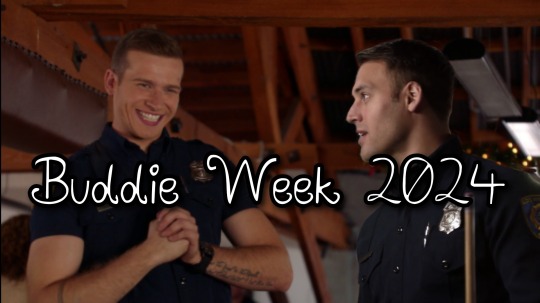
Hi everyone! I saw that there hasn't been a Buddie Week in a few years and that the account hosting this hasn't been active. I tried to get in contact but they never responded. Weeks dedicated to ships were always my favorites in different fandoms, so I decided, why not try to host it myself?
I am aware this can me stressful to do on my own, but I am giving it a chance! Besides, it'll be in 2024 so I'll have time to prepare.
That said, I want to ask YOU for some help figure out when this week should take place. This will happen in different polls.
First: today (November 3rd) this post will contain the first poll which season this week should be held:
Based on which season has the most votes, I will do another poll which month would be your favorite choice (unless December wins). Then when a month is chosen, there will be a poll which week should be used.
I might also do a poll which form of the week. Personally I use Monday-Sunday, but I know there are also people who use Sunday as the first day of the week.
Once we have chosen a week, we can start doing prompts! A form will be up for several weeks where you can suggest prompts. Then the most sent + my own favorites get put in a new form where you can vote.
There will be a poll to see if you want alternate prompts, multiple prompts a day to choose from, like @whumptober does for their events, or only 7 promps - 1 for each day. Then based on the amount of prompts needed, the ones with the most votes will be put in Buddie Week 2024.
Buddie week is for everyone!
You can do anything: Fics, gifsets, collages, video editing, picture editing, podcasts, playlists, podfics, art, poems. Whatever you want to create, you can do it!
EXCEPT THE USE OF AI IS FORBIDDEN!
AI technology steals from fellow artists and therefore it is against the rules to use AI to create something for Buddie Week.
I hope this is all the information you need to get excited! And I really hope to see people join to celebrate Buddie for a week!
Please share! You have my permission to share this post on other media like Twitter, Facebook, Instagram, Discord, anything. I hope to reach as many people as I can!
#911#911 buddie#buddie#buddie week#buddie week 2024#911 on abc#911 edit#911 abc#911 on fox#911 fandom#911 fanfic#911 fanfiction#buddie fanfic#buddie fanart#buddie fandom#buddie edit#evan buck buckely#evan buckley#eddie diaz#buck and eddie#buddie gifs
63 notes
·
View notes
Text
Tips for international student mobility, as a professional of the field - the general timeline
I tend to vent a lot about my job in private, because it is a LOT of work and a lot of resolving of very, very shitty situations and crises... but hell do I also love my job.
Thus, I will try to do regular posts giving the typical tips, the things to know, the good reflexes to have, and where to look for what information, as international student mobility is something that is getting more and more widely done, and more and more universities require an international mobility during your studies.
So...
For today, my focus will be on:
The timeline of an international mobility.
Have a good (long, 10-point) read!
If you have any questions, please ask them, I'll be happy to answer!

What office typically handles the international mobility of students?
That will be the international relations office.
You can find it named several types of ways, but as a general rule, look for the following key words:
international relations
outgoing
incoming
mobility
Pre-selections information period
Handled entirely by your university of origin.
There will be regular communications from the international office, inviting you to come to certain events and meetings to present what you need to know about.
Very often, they will also organise an International Day, where the former outgoing students and the current incoming students will come present their universities to you.
Those events are for your benefit. I really, highly recommend that you participate.
Additionally, they will offer a platform of information, where everything you need to know about the universities open for a mobility for you will be showcased. Those platforms are usually open for you from the moment you are allowed to do a mobility, and their access will be explained to you by the international office.
University selections campaign
Usually will happen between December and March for any mobility starting in the Fall/Winter semester, and between June and September for any mobility starting in the Spring/Summer semester. Keep in mind that some universities do all their selections at the same time, in December-March.
Generally speaking, universities will ask that you do several choices. Some will ask for 1-3 choices, others a dozen, others as many as you can.
If you cannot secure a spot in your first choice, you will have the second choice, unless it was already filled before you, then it is your third choice, etc.
Everyone will try to make it sound different, but here are the main 3 criteria that you have to keep in mind for the selections:
language requirements => you will not be able to be selected in a university for which you do not have the language level. The main languages will be English, Spanish, French, German and Italian.
academic requirements => some universities will ask for a minimum GPA. Again, if you don't reach that, you will not be able to be selected for it.
your results => outside of the requirements above, you will be ranked compared to the other applicants. If there are 3 spots available for a university, only the 3 best students who have chosen it will be selected for it.
Sometimes, the order of the choices will have an impact; if you're in a university where outgoing mobility isn't very spread out, your order of choices will allow some prioritisation of your first choice over other applicants; but go by the principle that the academic results will be the biggest criterium.
Nomination period
Once you have been selected, you will be introduced to your mobility coordinator, who will explain everything that will follow to you.
What is the nomination? It means that your outgoing coordinator will present your name and data to your receiving university, basically presenting you to them.
Timeline: Know that the nomination period can span from February to June for the Fall/Winter semester, and from June to December for the Spring/Summer semester! It will entirely depend on the country and on the university. Basically, the nomination periods will be impacted, at large, by the dates of the semester and the time it takes to get your visa.
Etiquette: Your mobility coordinator will be here to tell you exactly when to get in contact with your receiving university. Until then, refer to them and let them contact the university if you have any questions :)
As long as you haven't been nominated by your outgoing mobility coordinator, know that it is bad etiquette to contact your receiving university. Most will straight up ignore you if you do it too soon.
Application period
Once you have been nominated, you will be contacted by your receiving university, and you will have to submit your application, following the university's instructions.
Know that starting this point, your home university will gradually pass the responsibility of you to your host university, as they will be the one handling you during your mobility.
This can sound like a "big word", but know that it is a formality: unless you completely miss the deadline, the selections were done to ensure that you will have no trouble being accepted. It is however a mandatory step. Do not think that you can skip it!
A couple of weeks after your application, you will receive the Letter of Acceptance of the university. Only then can you start with the following two steps.
Accommodation research
Some universities can offer a room in their dorms, but not always. If they do, they will need you to have finished your application, in order to have you registered in their system. They will then explain to you what the rest of the procedure for accommodations is.
As a general rule:
European universities do not necessarily have space in their dorms, if they have dorms at all. It occurs more easily in Eastern Europe.
Asian universities usually have a dorm offer. Some universities will make them mandatory (Indian universities for example will tend to make them mandatory for exchange students), some will simply offer them as an option.
African universities will tend to offer dorms, but not mandated.
South American universities will not necessarily have dorms, and you will have to look for an accommodation for yourself.
North American universities will have dorms; most will try to secure rooms for their exchange students, but some will not be able to.
Visa application (if applicable)
Your outgoing mobility officer will do their best to help you if you need, but please know this: we are not competent for that.
I really, really recommend that you refer to:
your incoming mobility officer
the embassy of the country you're going to in your country
The outgoing officer's information is at risk of being outdated or not suited to the specifics of your situation. It is best to ask to the competent authorities.
Arrival
A few weeks before your arrival, the university will ask you to give them several pieces of information:
your date and time of arrival
your visa status
your address in the country
Try to answer those elements as quickly as possible, as they will need those to best organise for your arrival.
Please note that the visa process will probably not be finished after you receive your visa: a lot of countries will ask that you go by the local police/department of internal security within 2-4 weeks to register and confirm your presence in the country.
Important: for European students staying in Europe, some countries ask that you register at the police forces upon your arrival! This is an important step, please do not disregard it if it is mentioned!
During the semester
You will have to submit a Learning Agreement = your list of courses for the semester, signed by you, your home coordinator, and your host coordinator.
This document will tie all the parties to the proper completion of the courses indicated in this list.
You will have to choose courses in your host university that correspond to the academic requirements of your home university, so make sure that you check with your academic advisor at home whether your choices suit the needs for your semester.
This list of choices needs to be submitted to your home university before the deadline to change your courses at the host university.
Departure
In some countries, you will have to announce your departure to your university and to the local police forces; just think of doing that :)
For European universities, if you have an Erasmus grant, think of requesting the certificate of departure to the grant office in your home university and to have it signed by your incoming coordinator before you leave!
The weeks/months following
You will receive your Transcript of Records = your list of grades.
This document will be sent to you by your host university around 6-8 weeks after the end of the semester. Send it to your outgoing officer, and then your mobility will be officially over! :)
Good job, girlypops!

2 notes
·
View notes
Text
Trying to figure out Pacific Tech semester schedule

Okay so, we know that Pac Tech is largely based on Cal Tech, which uses a three semester schedule and the movie takes place between winter break(Mid-December to early January) and June 27th when they test the laser and Hathaway loses his house to popcorn
Now, I found the academic calendar for Cal Tech's 2005-6 (1984 started on a Sunday, so did 2006) and it's roughly layed out like First Term Sept 19-23 New Student Orientation Sept 26 Beginning of instruction Dec 7-9 Final examinations, first term Dec 9 End of first term Dec 10-Jan 3 Winter recess Second Term January 4 Beginning of instruction March 15-17 Final examinations, second term March 18 End of second term March 19-26 Spring recess Third Term March 27 Beginning of instruction June 7-9 Final examinations for undergraduates, third term June 10 End of third term Summer Term June 12 Summer term begins September 1 Summer term ends
Now we only see the students taking one final and no midterm which I always found weird, so that means that Pac Tech is probably following a two semester schedule. Also, we know from the script that Chris and Mitch have their breakthrough on the last day of finals and that the test of the laser occurs on the 27th of June and isn't long after the breakthrough.
So, Spring semester in Pac Tech is probably from Jan 4 - Jun 28th, which lasts for 26 weeks or 18 days over Cal Tech, jegus crust I'm guessing that their Fall semester is about 23 weeks long, Cal Tech is 13 weeks, would be from Jul 12 - Dec 20
Which means that a Cal Tech student is in school for 36 weeks and a Pac Tech student is in school for 49 weeks, over a four-year span means an extra 52 weeks, which explains how they shoved a five-year undergrad + masters program into a four-year college. Bc there is no way that Hathaway's team is a bunch of undergrads at the level of research they're doing

#real genius#real genius 1985#this is what happens when I sit out a semester for my health#I really need a tag for stuff I write#long post#I should do a headcanon list for Pac Tech#it seems like an intresting school
12 notes
·
View notes